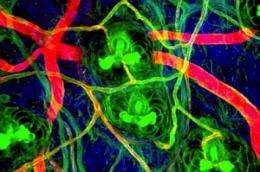Novel live-cell imaging technique offers new opportunities to understanding immune responses in the skin

Biologists often use a technique called multi-photon imaging to examine live cells. The technique is unique in that it uses multiple photons of high wavelengths to stimulate fluorescent labels, causing them to emit light. It is superior to more conventional fluorescence imaging techniques, such as confocal microscopy, as it has a higher spatial resolution and enables greater depth of penetration into tissues. Lai Guan Ng at the A*STAR Singapore Immunology Network and co-workers have extended the capability of multi-photon imaging further so that it can now be used to directly visualize immune responses in skin.
The skin is known to have two layers: the dermis and the epidermis. The epidermis is predominantly avascular, containing specialized skin cells called keratinocytes, whereas the underlying dermis contains highly vascularized lymphatic vessels. Conventional fluorescence microscopy only allows imaging into the epidermis and limited structures of the dermis below. The multi-photon imaging technique developed by Ng and his team offers simultaneous imaging of multiple cellular and structural components through the epidermis and into the dermis (see image).
The researchers provide a step-by-step guide to preparing a live mouse ear skin model which can be used to probe skin response to localized injury or disease over several hours. They placed a glass slide over the ear, which acts as a window through which to observe the tissue without surgery. The mouse ear is a good site for imaging because it requires minimal pre-treatment and is easily accessible.
The researchers could take images more quickly — for example, on a per-second basis — by adjusting various experimental parameters, thereby enabling them to study fast-moving cells such as rolling leukocytes.
The researchers recommend albino mice to prevent any artifacts arising from photodamage to the skin. They provide a comprehensive checklist for preparation of the ear for imaging to ensure that the integrity of the blood vessels is not being compromised. They also describe a protocol to induce local laser injury, the biological response of which can then be studied. The protocol has a troubleshooting section that can be used to resolve problems that others may encounter when they come to repeat the experiment.
So far, the researchers have used their approach to study a variety of skin conditions, for example, parasitic infection, T-cell lymphoma migration and neutrophil response to sterile injury amongst others.
“We envision that this approach will not only continue to unravel new knowledge relating to the skin immune system, but also gradually become a standard approach for assessing drug delivery as well as percutaneous and intradermal vaccine applications in preclinical studies,” says Ng.
More information: Li, J. L.-Y. et al. Intravital multiphoton imaging of immune responses in the mouse ear skin. Nature Protocols 7, 221–234 (2012).













